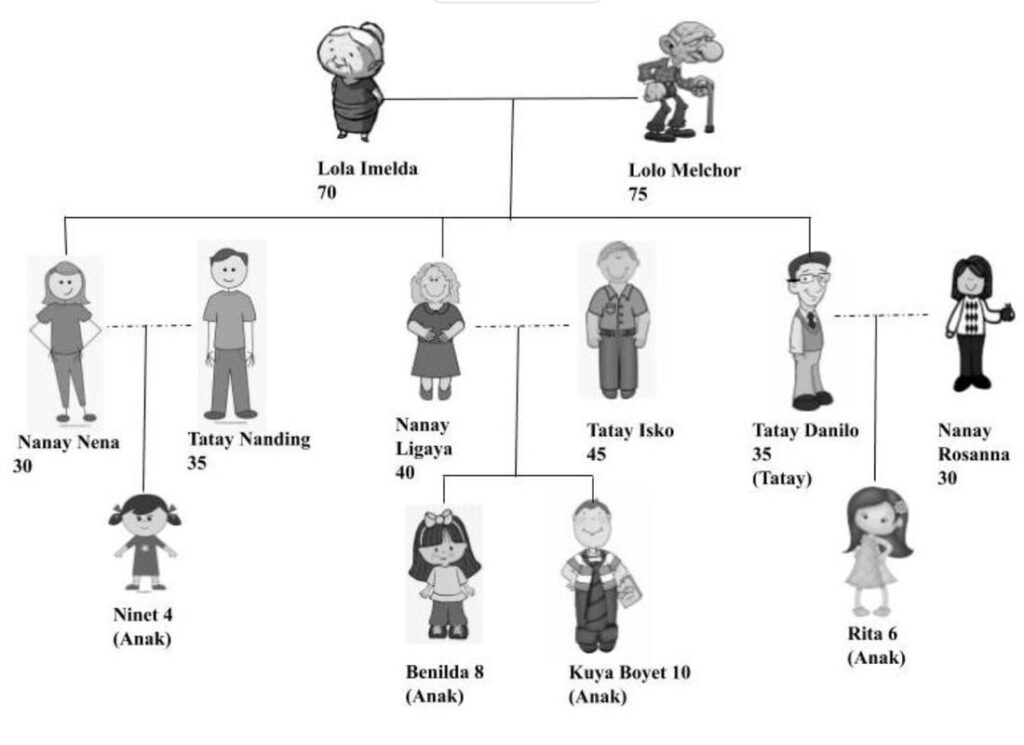Ang aking Pamilya
written by Pia Arboleda and Lanail Manio
Background
Members of family, adjectives, affirmative/negative sentences, constructing yes/no questions in Filipino. Possessive pronouns (ko & nyo).
OCCUPATIONS/PROFESSIONS

Motivating Activity
This section provides interactive activities to help you practice and deepen your understanding of key Filipino phrases and concepts. Please follow the instructions for each exercise.
1. Reviewing Basic Introductions & Affirmations
Let’s review fundamental phrases for self-introduction and simple affirmations/negations. Practice saying these aloud or in writing:
- Review of ____ ako, hindi ako —-
- Introduce “ka” (you)
- Estudyante ka (Are you a student?)
- Hindi ka titser. (You are not a teacher.)
Practice Conversation:
- A: Estudyante ka ba? (Are you a student?)
- B: Oo, estudyante ako. (Yes, I am a student.)
- A: Titser ka ba? (Are you a teacher?)
- B: Hindi ako titser. (No, I am not a teacher.)
2. Expanding with Third-Person Introduction (Siya)
Now, let’s practice introducing a third person using “Siya” (he/she). This exercise focuses on extending your vocabulary for family members and professions.
Example Sentences:
- Ito ang nanay ko. (This is my mom.)
- Doktor siya. (He/She is a doctor.)
Fill in the Blanks:
Complete the following sentences by filling in the blanks:
- Ito ang (nanay / tatay / kapatid / lolo / lola) ko. (This is my )
- siya. (He/she is ____. – for profession/description)
- Hindi siya ____. (He/she is not ____. – for profession/description)
3. Writing Practice: Constructing Sentences
Strengthen your Filipino sentence construction skills with these writing exercises:
- Write ten sentences using the “____ ka” structure.
- Write ten sentences using the “Hindi ka ____” structure.
4. Interactive Language Relay Games
Engage in dynamic conversational practice with these relay games:
- Language Relay Game (Create your own dialogue):
- A: ____ ka ba? (Are you ____?)
- B: Answer yes or no.
- Relay Language Game (Introducing others):
- A: ____ ba siya? (Is he/she ____?)
- B: Answer yes or no.
- Introduce: Hindi ba siya ____? (Isn’t he/she ____?)
- Introduce: Hindi ka ba ____? (Aren’t you ____?)
Culminating Activity: Family & Presentation
This final activity brings together your learning to introduce family members and review the module’s content.
- Activity: Introduce Family Members (Refer to Handout: Family Tree)
- Activity: Family Tree (info-gap)
- Presentation: Review key concepts from the module.
Go over pronunciation before hand
Exercise: Ang Pamilya (The Family)
This interactive exercise is designed to help you practice Filipino vocabulary for family members and numbers. You will work with a partner, each with slightly different information, to complete your family trees.
Important: This activity requires two participants. Do NOT show your partner their family tree or reference list until the activity is complete.
Reference Vocabulary
Keep these terms handy during the exercise. The numbers in parentheses refer to ages.
- lolo / lola – grandpa/grandma/grandparents: dalawampu (20)
- anak – son/daughter: tatlumpu (30)
- asawa – spouse: apat na pu (40)
- kuya / ate – brother/sister: limampu (50)
- pamangkin – nephew/niece: anim na pu (60)
- nanay / tatay / magulang – mother/father/parents: pitompu (70)
- babae / lalake – woman / man: walumpu (80)
- pinsan – cousin: siyam na pu (90)
- bayaw – brother/sister-in-law
Activity Steps
Go over pronunciation before hand.
Step 1: Identify Unlabeled Family Members
Instructions for Partner A / Student A: Study the family tree below. You and your partner are trying to find out all the information about your family. Your partner has the same tree, but with different information. Talk with your partner and identify the people who are unlabeled in your tree. DO NOT SHOW THEM THE TREE!

Model Question (Partner A): Sino ang asawa ni Alison? (Who is Alison’s spouse?)
Step 2: Complete Missing Ages
Instructions for both partners: The ages are missing for some people in the family tree. Talk with your partner to complete the tree with the ages that are missing.
(Insert Family Tree Image for Partner B / Student B here – the one showing ages missing. This image might be the same as Partner A’s but with different or fewer labels/ages.)
Model Question (Partner B): Ilang taon na si Ema? (How old is Ema?)
Step 3: Describe Your Own Family Tree
Instructions for both partners: Now take turns describing your own families. While one partner describes, the other should draw the family tree being described.
Culminating Activity
Show & Tell: Bring a photo of your family or find a family photo of a famous celebrity. Talk about each person in the photo by describing their relationship with each other and occupation. Use the adjective chart to describe their personality. Be sure to include the use of hindi and wala in your description.
Audience: Audience will be welcomed to ask YES/NO questions. The same question may not be repeated. For example, if a student asks Guro ba siya? They should be encouraged to ask a unique question such as Nars ba siya? Audience should also take notes on what they learned from at least 3 classmates. Notes may be written in their L1, but the final submission must be written in Filipino.
Enrichment Activity
Interview a friend or a classmate about their family. Formulate questions you want to ask and create a family tree based on the results of your interview.
Sample questions:
Ano ang pangalan ng lola mo?
Guro ba siya?
Taga saan siya?
At this level, students are not able to comprehend answers to open-ended questions. Students should formulate as much YES/NO questions to gain information about each family member.